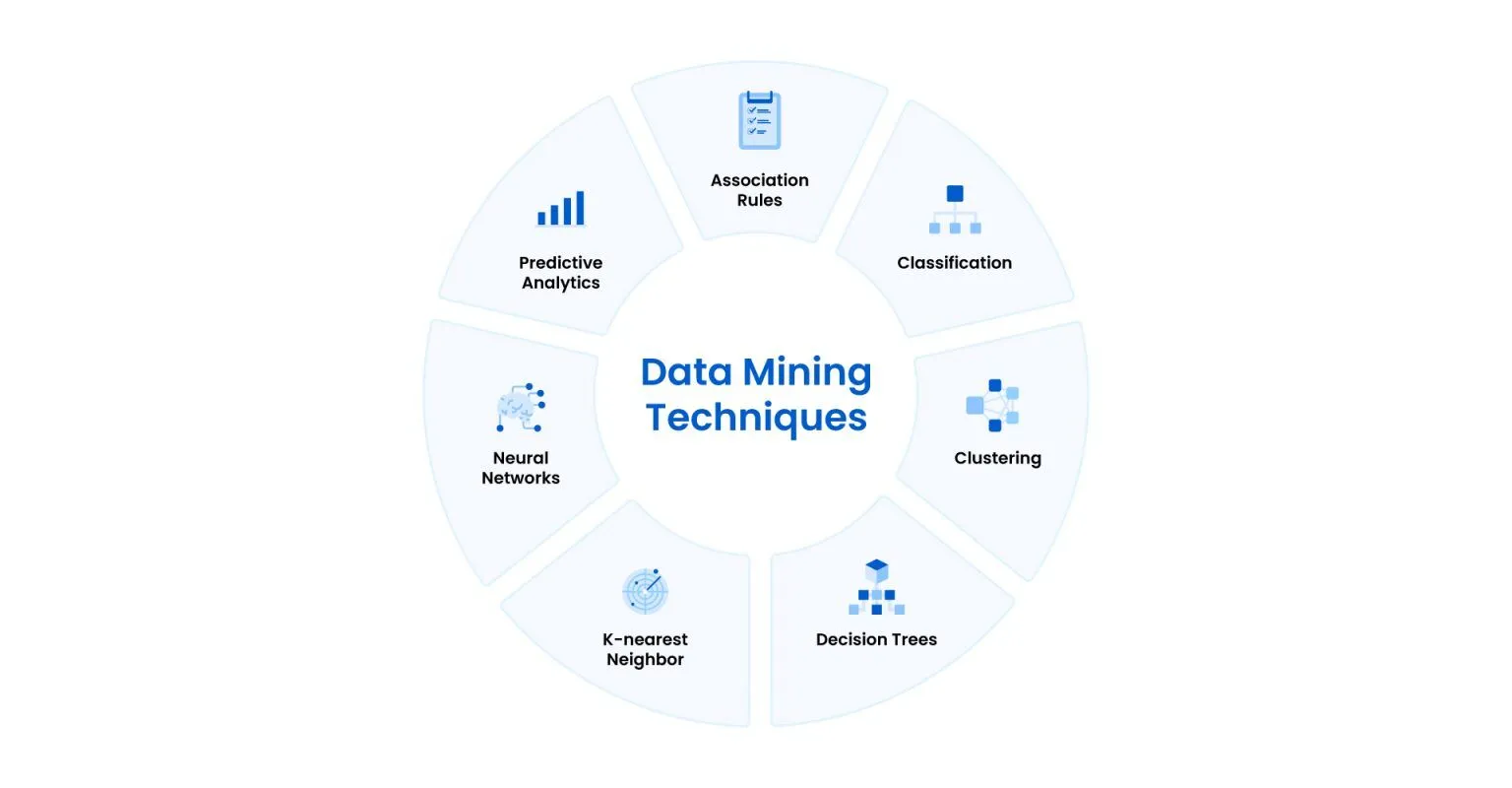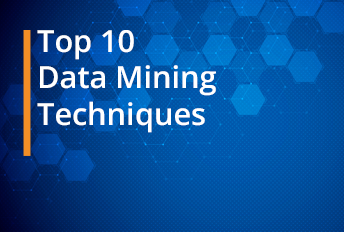
The 8 Best Data Mining Tools in 2025: Features, Pros, Cons, and Use Cases
What Is Data Mining?
Data mining, also known as Knowledge Discovery in Data (KDD), is a powerful technique that analyzes and unlocks hidden insights from vast amounts of information and datasets. Data mining goes beyond simple analysis—leveraging extensive data processing and complex mathematical algorithms to detect underlying trends or calculate the probability of future events.

What are Data Mining Tools?
Data mining tools are software that assist users in discovering patterns, trends, and relationships within vast amounts of data. They come in various forms, from simple to complex, catering to different needs.
– Data visualization and simple pattern recognition.
– Quick and easy to learn.
– Lack advanced algorithms and features.
– Comprehensive machine learning capabilities.
– Customizable and extensible.
– May overwhelm beginners.
– Specialized features relevant to the industry.
– Efficient for specific use cases.
– May not cover all data mining needs.
– Distributed processing capabilities.
– Handles parallel processing efficiently.
– Requires expertise in distributed computing.
– Useful for sentiment analysis, topic modeling, etc.
– Supports natural language processing.
– May struggle with noisy or poorly formatted text.
– Useful for competitive intelligence and content extraction.
– Automates data collection from websites.
– May encounter legal and ethical issues.
Why Are Data Mining Tools Important?
Data mining allows businesses to analyze historical data, helping them predict future outcomes, identify risks, and optimize processes. Data mining tools help organizations solve problems, predict trends, mitigate risks, reduce costs, and discover new opportunities. Whether it’s choosing the right marketing strategy, pricing a product, or managing supply chains, data mining impacts businesses in various ways:
- Finance: Banks use predictive models to assess credit risk, detect fraudulent transactions, and optimize investment portfolios. These tools enhance financial stability and customer satisfaction.
- Healthcare: Medical researchers analyze patient data to discover disease patterns, predict outbreaks, and personalize treatment plans. Data mining tools aid early diagnosis, drug discovery, and patient management.
- Marketing: Marketers rely on customer segmentation, recommendation engines, and sentiment analysis. These tools enhance targeted advertising, customer retention, and campaign effectiveness.
- Customer Insights: Data mining tools enable users to analyze customer interactions, preferences, and feedback. This helps them understand customer behavior and pinpoint buying patterns, allowing them to tailor offerings, improve customer experiences, and build brand loyalty.
- Process Optimization: Data mining tools help identify bottlenecks, inefficiencies, and gaps in business processes. Whether it’s supply chain logistics, manufacturing, or service delivery, these tools optimize operations, reduce costs, and enhance productivity.
- Competitive Advantage: Data mining tools help businesses harness data effectively, revealing market trends, competitor strategies, and emerging opportunities.
Get Started with Faster, Smarter Data Pipelines
Ready to cut down on time and effort in your ETL projects? Discover Astera Data Pipeline Builder today and see how AI-powered automation can simplify your data handling, no coding needed.
Request a DemoTop 8 Data Mining Tools in 2025
1. Apache Mahout
Apache Mahout is a linear algebra framework that supports scalable machine learning and data mining. It offers several algorithms and tools tailored for developing machine learning models capable of processing large datasets.
With its distributed architecture, Apache Mahout allows scalability over machine clusters. It also allows mathematicians and data scientists to create and execute custom algorithms for various machine-learning models.
Key Features:
- Mathematically expressive Scala DSL
- Support for multiple distributed backends (including Apache Spark)
- Integration with Hadoop and Spark
- Scalability
- Algorithm support
Pros:
- Can handle large datasets.
- Offers fast model training and prediction times.
- Supports a wide range of machine-learning algorithms.
- Integrates with platforms like Hadoop.
Cons:
- There’s a high learning curve for using Apache Mahout.
Best For:
Implementing custom machine learning algorithms.
2. MonkeyLearn:
MonkeyLearn is a machine-learning-based text analysis platform. It utilizes artificial intelligence to analyze and understand textual data. Therefore, it can help businesses extract insights from text-based sources such as social media posts, customer reviews, articles, and more.
Key Features:
- Text Mining Specialization
- Custom Machine Learning Models
- No Code
- Integration Capabilities
Pros:
- Easy to use and integrate with other platforms.
- Can handle large volumes of data.
- Offers fast model training and prediction times.
Cons:
- Sometimes the segregation is generic based on the email content and needs more examples to learn.
- Financial category is not easily segregated/tagged.
- Challenging to have Monkey Learn bucket support tickets into distinct user-readable buckets based on ticket text.
Best For:
Businesses that need to process large volumes of data quickly and easily integrate their data mining models with other platforms.
3. Oracle Data Mining:
Oracle Data Miner is an extension to Oracle SQL Developer for data scientists and analysts. It enables users to leverage Oracle databases for building, evaluating, and comparing machine learning models directly within the database environment.
Oracle Data Miner provides access to advanced algorithms for data mining and machine learning. Users can integrate these algorithms into their SQL queries, allowing efficient model-building and evaluation processes within the familiar Oracle SQL Developer interface.
Key Features:
- Interactive Workflow Tool
- Explore and Graph nodes for visualizing data
- Automated Model Building features
- Integration with RWorks with Big Data SQL
Pros:
- Seamless integration with the Oracle Database Enterprise Edition.
- Can handle large volumes of data.
- Offers a graphical user interface for easy data mining.
- Multiple data mining algorithms and techniques are available.
Cons:
- Requires more technical knowledge to use effectively.
- Microsoft Excel is required to decrypt data.
- Integration failures can occur due to complexity in the system across other platforms.
- Dependence on Oracle Database.
Best For:
Businesses that require a wide range of data mining algorithms and techniques and are working directly with data inside Oracle databases.
4. Sisense
Sisense is a data analytics platform emphasizing flexibility in handling diverse data architectures. It offers the ability to connect with various data sources, which benefits businesses with complex data structures.
The data mining platform offers features such as data preparation, exploration, and the creation of machine learning models, all aimed at optimizing performance and quality.
Key Features:
- Ad-hoc Analysis
- Centralized Data Hub
- Data Connectors
- Scalable Data Handling
- Interactive Dashboards
Pros:
- Easy to use and integrate with other platforms.
- Can handle large volumes of data.
- Offers fast model training and prediction times.
Cons:
- Limited to certain types of models (e.g., classification, regression, and clustering).
- May not be suitable for businesses with complex data mining needs.
Best For:
Businesses that require a user-friendly interface for creating and deploying predictive models.
5. SAS Enterprise Miner
SAS Enterprise Miner is a data mining tool offering offers various predictive modeling, data mining, and analytics capabilities. The data mining tool provides users access to various statistical, data mining, and machine learning algorithms.
Key Features:
- Interactive GUI and batch processing
- Data preparation and exploration
- Model building and evaluation
- Multithreaded high-performance procedures
- Self-sufficiency for business users
Pros:
- Easy to use and integrate with other platforms.
- Can handle large volumes of data.
- Offers fast model training and prediction times.
Cons:
- Users expressed their dissatisfaction with the software’s interface.
- Several users have found the software difficult to learn.
Best For:
Businesses that need to process large volumes of data quickly and easily integrate their data mining models with other platforms.
6. Knime
KNIME is an open-source analytics platform. It’s notable for its adaptable and modular design. It equips users with the capability to conduct extensive data transformations, explorations, and analyses, all facilitated by a user-friendly graphical interface.
Knime’s modular structure allows for the straightforward assembly and personalization of data workflows. It also connects to an array of pre-designed nodes and components.
Key Features:
- Drag-and-drop workflow creation
- Integration with R
- Open-source nature
- Customizable workflows
- Community support
Pros:
- Easy to use and integrate with other platforms.
- Can handle large volumes of data.
- Offers fast model training and prediction times.
- Accessible and customizable due to its open-source nature.
Cons:
- Some users have reported issues integrating Knime with specific platforms, such as Jupyter notebooks.
Best For:
Businesses that require robust data analytics capabilities without the complexity of more intricate data mining systems.
7. Orange
Orange is an open-source tool for data mining, visualization, and analysis, crafted to support exploratory tasks and interactive visualizations.
The tool comes equipped with an extensive array of visualization instruments and widgets, enabling the examination and analysis of various datasets.
Key Features:
- Visual programming
- Machine learning widgets
- Customizable machine learning models
- Pre-trained classifiers and extractors
- No coding required
- Versatility
Pros:
- Can handle large volumes of data.
- Offers fast model training and prediction times.
- Offers various machine learning algorithms.
- Integrates with platforms like Python.
Cons:
- Manual Troubleshooting.
- Advance analysis is not so easy.
- Support isn’t always reliable.
- A high learning curve.
Best For:
Businesses that need to visually program custom machine learning models.
8. RapidMiner
RapidMiner is an open-source platform widely recognized in the field of data science. It offers several tools that help in various stages of the data analysis process, including data mining, text mining, and predictive analytics. The data mining tool is designed to assist users in extracting insights from data.
Key Features:
- Distributed Algebraic optimizer
- R-Like DSL Scala API
- linear algebra operations
- Text analysis and sentiment detection
Pros:
- Easy to use and integrate with other platforms.
- No coding skills needed
- Easy to set up
- Dashboard is clean
- Offers fast model training and prediction times.
Cons:
- Performance issues with large datasets
- Software stability
- Data output limitations
Best For:
Businesses that need to process large volumes of data quickly and easily integrate their data mining models with other platforms.
How to Choose the Right Data Mining Tool
Selecting the appropriate data mining tool can significantly influence the outcomes of data analysis efforts. To assist users in navigating this choice, the following guide outlines the essential considerations for choosing a data mining tool that aligns with their specific needs:
1. Understanding Data Requirements
Before diving into the selection process, users must have a clear understanding of their data:
- Data Types: It’s imperative to ensure that the chosen data mining tool is adept at handling the particular types of data users work with, be it structured or unstructured.
- Data Volume: The tool’s capacity to efficiently process the amount of data users plan to analyze should not be overlooked.
2. Define Your Requirements
Clarifying requirements upfront can streamline the selection process:
- Analytical Needs: Users should pinpoint the types of analysis they aim to conduct, such as predictive modeling, clustering, or regression.
- User Expertise: The data mining tool should correspond to the proficiency level of its users, catering to environments ranging from code-intensive for data scientists to graphical user interfaces for business analysts.
3. Evaluate Tool Capabilities
A thorough evaluation of the data mining tool’s capabilities is crucial:
- Functionality: Seek out tools that boast a comprehensive feature set in line with the analytical tasks users intend to perform.
- Performance: The tool’s capability to manage complex computations and sizable datasets is a key performance indicator.
- Scalability: The chosen tool should accommodate the growth of user data needs and remain relevant as their organization develops.
4. Integration and Compatibility
The data mining tool’s ability to integrate and coexist with existing systems is vital:
- Data Sources: Confirm that the tool offers support for the data sources that users employ.
- Software Ecosystem: The degree to which the tool integrates with other software in the user’s tech stack, such as databases, BI platforms, or cloud services, should be considered.
5. Support and Documentation
The level of support and resources available can greatly affect user experience:
- Vendor Support: Opt for data mining tools that are supported by dependable vendor assistance or a strong user community.
- Documentation and Training: Adequate learning materials and troubleshooting guides are essential for mastering the tool and resolving potential issues.
6. Trial and Testing
Hands-on experience with the tool can provide valuable insights:
- Free Trials: Users are encouraged to utilize free trials or community editions to gauge the data mining tool’s capabilities firsthand.
Weighing these factors can help users choose a data mining tool that satisfies their immediate requirements. It’s important to remember that the most suitable tool is the one that best harmonizes with the users’ data, objectives, and available resources.
Build high-performance data pipelines in minutes with Astera
14-Day Free TrialThe Prerequisite to Data Mining: Astera Data Pipeline Builder
Effective use of data mining tools requires meticulous data preparation and processing. This is where Astera Data Pipeline Builder, a leading end-to-end data integration platform, comes into play.
Astera Data Pipeline Builder offers a comprehensive suite of features that swiftly prepares data for analysis. It empowers users to construct end-to-end data pipelines, leveraging sophisticated ETL features and a robust enterprise-grade integration engine.
A key aspect of data preparation is the extraction of large datasets from a variety of data sources. ADPB excels in this area, offering automated and bulk extraction from disparate sources, including unstructured sources, databases, data warehouses, cloud data providers, file systems, transfer protocols, web services, and various file formats.
Transformation and conversion capabilities are another crucial component of data preparation. ADPB provides users with advanced tools for reformatting data to meet specific analysis requirements or converting data from one format to another, ensuring both flexibility and efficiency.
Data quality is a priority for the tool. It incorporates built-in features for data cleansing and scrubbing, and its rule-based data quality verification ensures the accuracy and integrity of data.
Finally, Astera Data Pipeline Builder’s user-centric design simplifies complex tasks. Its intuitive drag-and-drop or single-click operations eliminate the need for extensive coding, significantly boosting productivity and efficiency in data mapping, validation, and cleansing tasks. In essence, it provides a comprehensive solution for making data analytics-ready, thereby facilitating efficient data mining.
Key Features:
- AI-Driven Data Management: Streamlines unstructured data extraction, preparation, and data processing through AI and automated workflows.
- Enterprise-Grade Integration Engine: Offers comprehensive tools for integrating diverse data sources and native connectors for easy mapping.
- Cloud-Based Data Preparation: Ensures data quality using data health monitors, interactive grids, and robust quality checks.
- Advanced Data Transformation: Offers a vast library of transformations for preparing analysis-ready data.
- Dynamic Process Orchestration: Automates data processing tasks, allowing for execution based on time-based schedules or event triggers.
- User-Centric Design: With its no-code, drag-and-drop interface, Astera makes data management accessible to users of all technical backgrounds.
- Seamless Integration: Integrating with a wide array of data sources, both on-premises and cloud-based, ensures a smooth data management experience.
- Comprehensive Data Handling: Offers a unified platform for all data-related tasks, from extraction to insights, backed by a vast library of data operations.
How Astera Data Pipeline Builder Enables Robust Data Mining Workflows
Data mining helps organizations extract valuable insights from their data. However, without automated data pipelines, it’s difficult for organizations to ensure the integrity and usefulness of data throughout the analysis process.
The AI-powered, cloud-based Astera Data Pipeline Builder empowers organizations to create data pipelines with minimal effort, leveraging automation to streamline the data mining process.
Data pipelines play a pivotal role in processing data from disparate sources. They seamlessly integrate data from various origins and transform it into a format that is ready for analysis. This transformation process, which includes data cleaning, normalization, aggregation, and conversion, ensures a consistent and unified view of data.
Furthermore, data pipelines offer the advantage of real-time processing, providing up-to-date information that is crucial for prompt decision-making. Automated data pipelines also save time and resources by reducing manual errors in the extraction, transformation, and loading (ETL) process.
As organizations grow, their data grows correspondingly. Data pipelines, designed to scale, accommodate this growth, ensuring the data infrastructure keeps pace with organizational needs.
Lastly, data pipelines prioritize maintaining high data quality. They ensure data consistency, identify and correct errors, and remove duplicates through built-in features for data cleansing, validation, and verification.
Here’s how Astera Data Pipeline Builder achieves this:
- An All-in-One Platform: Users can combine their ETL, ELT, data preparation, and API-related workflows in one place without the need for separate tools.
- Support for Varying Latencies: Astera Data Pipeline Builder supports different latencies, easily meeting users’ real-time, near real-time, and batch data processing needs.
- AI-Driven Semantic Mapping: ADPB automatically maps and aligns data between sources and destinations to boost accuracy.
- AI-Powered Document Extraction: Astera’s advanced AI technology enables users to capture data fields from unstructured files.
- Data Transformation and Conversion: Users can easily transform and prepare datasets for analysis using built-in transformations.
- Automated Rule-Based Data Quality: Users can ensure data extracted is accurately and reliably through rule-based verification and correction.
- No-Code Data Integration: Allows business users to manage complex data processes with minimal IT intervention, thanks to its no-code platform.
- Automation: Astera’s automated approach simplifies data pipeline creation and management. Users can extract, transform, validate, and load data seamlessly, which significantly reduces manual effort and the potential for errors.
- Scalability: Astera’s solution is capable of handling growing data volumes and complexity without a drop in performance.
Ready to transform your data mining processes with unparalleled efficiency and ease? Download your free 14-day trial and experience the power of seamless data integration or schedule a personalized demo to see Astera Data Pipeline Builder in action.
 Astera AI Agent Builder - First Look Coming Soon!
Astera AI Agent Builder - First Look Coming Soon!


